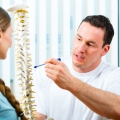Patients experiencing low back tenderness and pain may benefit from a sacroiliac (SI) joint evaluation from Dr. Mark Giovanini of NeuroMicroSpine! Dr. Giovanini takes a comprehensive approach to assessing a patient’s SI joint and may evaluate the patient’s medical history, perform a physical examination, review imaging studies and/or administer diagnostic injections to pinpoint the patients pain. Continue reading to learn more about sacroiliac joint evaluation and treatment with Dr. Giovanini!
 Depending on the location of the patient’s pain and symptoms, Dr. Giovanini may assess not just the SI joint, but the whole spine and hips to find the exact source of the patient’s pain. As mentioned previously, there are a number of diagnostic tools and techniques involved in this type of examination, primarily because the SI joint can be incredibly challenging to test.
Depending on the location of the patient’s pain and symptoms, Dr. Giovanini may assess not just the SI joint, but the whole spine and hips to find the exact source of the patient’s pain. As mentioned previously, there are a number of diagnostic tools and techniques involved in this type of examination, primarily because the SI joint can be incredibly challenging to test.
Palpation of the SI joint may be the simplest way to assess pain or dysfunction, but it’s recommended other tests are involved for conclusive results. According to an article titled “Palpation of the Sacroiliac Joint: An anatomical and Sensory Challenge,” there is a challenge that comes with palpating the posterior SI joint because it is roughly 5-7 cm below the skin. Therefore, patients should see a physician like Dr. Giovanini who performs a series of tests.
Another commonly performed technique requires assessing the range of motion of the SI joint and it’s symmetry. This method is also relatively easy to perform. It may be a common practice among physicians because it’s valuable in spotting severe misalignment and poor movement. These two “tests” in conjunction with one or more of the following provocative tests can help diagnose SI joint pain:
1. FABER- FABER stands for “flexion, abduction, external rotation” and requires a physician to stabilize the pelvis and apply force to the opposite anterior ASIS.
2. Distraction- Distractionrequires a physician to apply pressure on both the anterior and medial aspects of the patient’s left and right ASIS.
3. Gaenslen- Gaenslen requires a physician to apply “torsional” stress on the SI joints.
4. Thigh Thrust- Thigh thrust requires a physician to apply increasingly steady pressure on a patient’s flexed leg while stabilizing the opposite ASIS.
5. Compression- Compression requires a physician to place downward pressure on the lateral side of the patient’s hip.
A combination of these tests may provide the best results on SI joint pain. Treatment will be determined after the results of the test. Treatments may include SI joint injections, physical therapy and/or a brace, or in severe cases, a minimally invasive SI joint fusion. To get your low back pain checked out, call Dr. Mark Giovanini of NeuroMicroSpine today!
For more information on minimally invasive spine surgery or to make an appointment with Dr. Giovanini, please call (850) 934-7545 or visit http://www.neuromicrospine.com/request-appointment.
We hope to see you soon!
The advice and information contained in this article is for educational purposes only, and is not intended to replace or counter a physician’s advice or judgment. Please always consult your physician before taking any advice learned here or in any other educational medical material.
©NeuroMicroSpine, 2015
©Medical Marketing Solutions, 2015
